The 1993 Toyota Supra Turbo Takes on the Chevy Corvette LT1, Mazda RX-7, Mitsubishi 3000GT VR4, Nissan 300ZX Turbo, and Porsche 968.
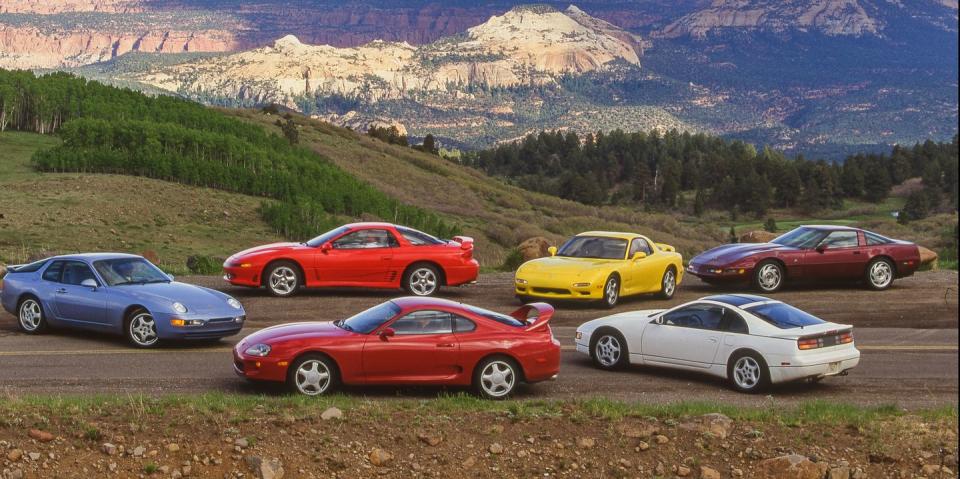

Our reviews of Toyota's four- and six-cylinder 2021 Supras are coming tomorrow morning, until then we decided to look back at where the Supra started. Here's our comparison test of the fourth-generation Supra Turbo from the September 1993 issue of Car and Driver.
If you're sideways, you've done something wrong. Ask any peace officer east or west of the Pecos. But you know you're in the West and straight with the law when instant-on radar nails you at some notably illicit speed and the lawperson poking the kill button pays no nevermind because this is the Great Spaces, where a constable’s common sense still has a calling and sees that you’re alert and in control of your projectile, and the patrolperson just gits on down the road. That, ladies and gentlemen, is a thrill.
So take heart. Venturing over the edge-call it the cowboy's need to straddle bulls, the cowgirl's urge to linedance with wolves, the city slicker's forced inclination to try roping rattlers—is only and forever human nature, and not assumed to be suicidal or worse. Sticking out our necks with a big-fool grin on our faces is a specialty of our species.
So. Here before us are six blazingly fast sports/GT cars-a nice round number, most of them nicely rounded—all meant to cater to the big-grin side of your soul. To punch big holes in the air. To put the road shrinking behind you into the long-ago.
Some of these half-dozen machines lean toward grand touring as a prime avocation. Others are professionally turned out in most every aspect of sporting behavior. Yet these cars have one thing in common: they allow the driver in you to push your luck as far as you can get away with. Or think you can.
Taken alphabetically, our half-dozen cars are the familiar Chevrolet Corvette LT1, Mazda RX-7, Mitsubishi 3000GT VR4, Nissan 300ZX Turbo, and Porsche 968. Plus the altogether new Toyota Supra Turbo.
Other than the 968. which dido 't make it the last time we pulled off one of these king-hell comparos, the others have been bested repeatedly by the superb 300ZX Turbo. But they've all been improved in increments. Besides, Toyota has wholly reconstituted and outrageously energized the Supra. A tough new car under a comfortable old name, it means to kick the Crayolas out of the whole colorful lot of its natural enemies. This will be the first American road test of an actual production specimen.
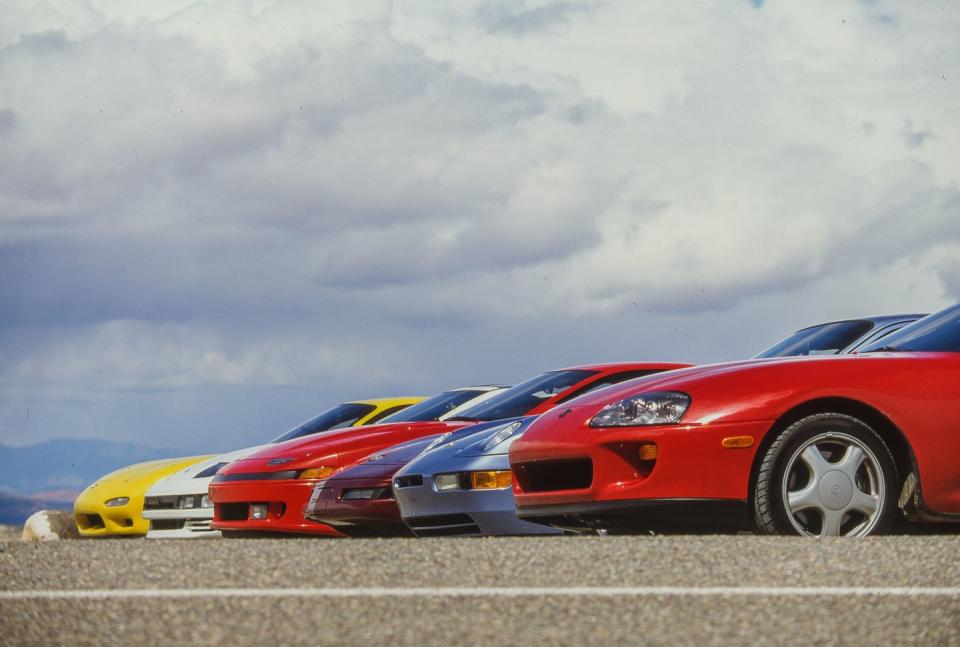
Today is the first sunny day of five to come, a window-streaming of Cinemascopic places that fulfilled the promise of Technicolor for big-screen westerns and will, in a few hours, fill our car windows to overflowing. We're spurring toward Utah, a state as vivid in its color and variety as are the cars (see sidebar). Official testing will end with Hungarian Hot Laps back in California, at Willow Springs Raceway.
These coupes are the cream of a rich cash crop. Most can be had for $40,000 or so, give or take a few thousand based on options, manufacturer's name, country of origin, and "luxury" tax. In this case, it's sort of a go-fast tax, because that's what the bottom line really buys: speed.
Mazda's RX-7 is the smallest and lightest and costs the least: base price, $33,603. As tested, it totals a relatively thrifty $35,252, though the R1 performance package doesn't provide the niceties of Mazda's Touring package, which would have made it more like the other combatants in price and amenities.
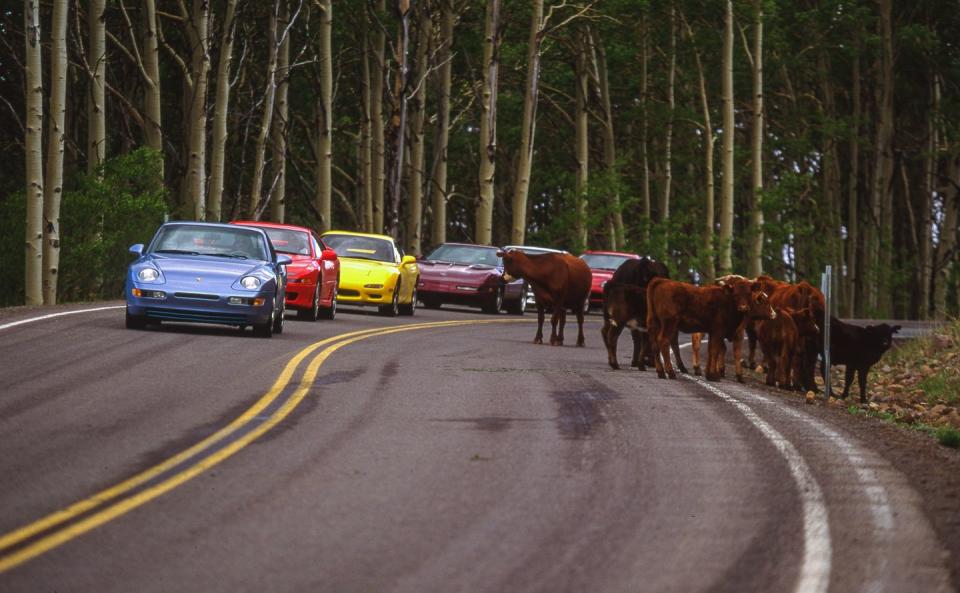
Porsche's 968 is the least quick of the cars yet the most pricey. Often 968s have found themselves languishing in showrooms, suffering from a $41,743 base price (Porsche's lowest)! As tested—with leather, a limited-slip differential, seventeen-inch wheels, and radio/CD—this one listed for $47,443.
The glossy new Supra Turbo can hit the road for $40,890-$43,734 for the one we tested, with big wing, leather seats, CD player, and programmable equalizer. The only options this Turbo lacked were Toyota's four-speed automatic and a lift-out "sport roof." (Our experience suggests that such roofs should be avoided to minimize squeaks and rattles, especially in cars that feed high loadings from acceleration, braking, and cornering through the structure.)
Not far above the bargain-basement Mazda was the Corvette at $35,660, $41,026 as tested with the Selective Handling and 40th Anniversary packages, plus A/C, stereo, and power seats. The Mitsubishi, base-priced at $38,492, bore about $1400 worth of extras including leather upholstery, for a tab of$39,876. The $38,806 Nissan was the only car in the test to arrive without extras, so well-equipped in standard form that it didn't want for anything.
All six engines make knockout power for their sizes and types. All are fitted with electronic engine-control systems and port fuel injection. Except for the old-timey pushrod design of the Corvette LT1 V-8, with two valves per cylinder, the cars all wear dual-overhead-cam heads that allow them to rev freely and to breathe easily through four valves per cylinder. (The faster DOHC 32-valve ZR-1 Vette didn't qualify for this group because it's way too expensive.) The engines' official outputs varied from the Porsche's 236 hp to the Toyota's 320; torque ranged from the Mazda's 217 lb-ft to the Chevy's 340.
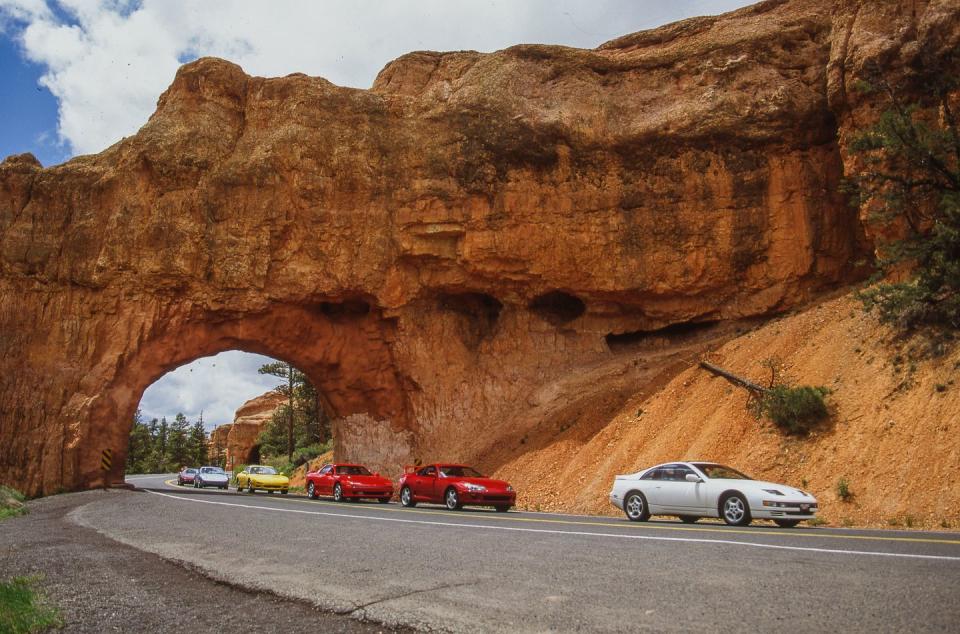
Curb weights covered a 1020-pound spread, from the Mazda's feathery 2840 pounds to the Mitsubishi's hefty 3860. The cars' weight distributions front-to-rear were also distributed in a wide band. The Mitsubishi, whose all-wheel-drive system plunks extra weight on the front wheels, rolls across the scales with 57.5 percent of its mass on the front tires. The Porsche, whose rear-mounted transaxle shifts poundage aft, carries only 48.5 percent of its load up front. And the wee Mazda, whose small, light rotary engine sits mostly behind the front wheels, delivers exactly the 50/50 weight distribution that's lauded for handling balance by vehicledynamics theoreticians.
Half the cars had five-speed gearboxes, half had six-speeds. And they varied in feel, gearing, and noise characteristics.
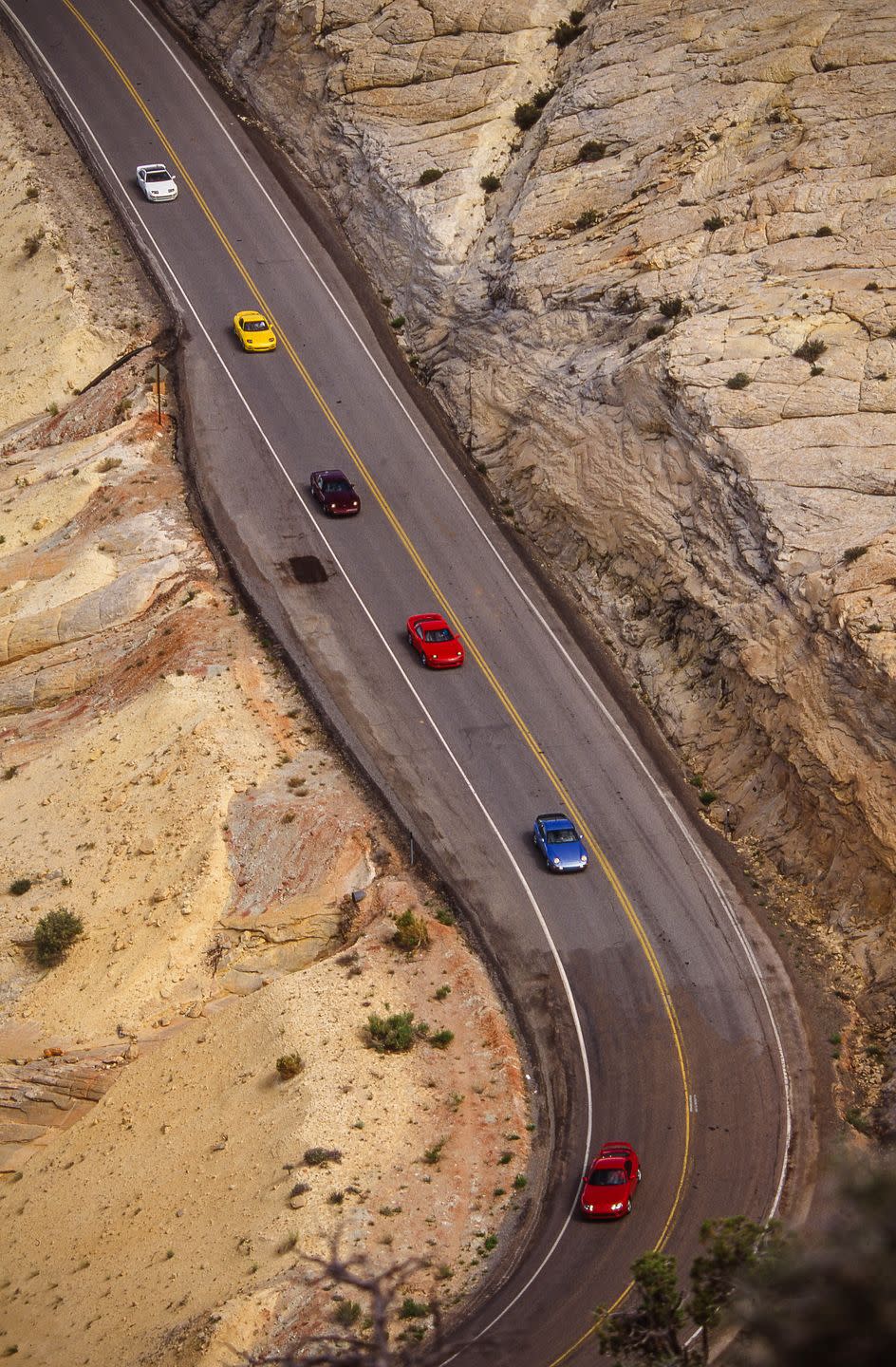
All the cars had fully independent suspensions and vented four-wheel disc brakes with ABS. The suspensions, however, varied as much in over-the-road performance and in feel as their layouts differed in detail. A car-length in distance separated the longest and shortest stops from 70 mph—a concern when 70 mph is well under half the speed potential.
The Corvette, the RX-7, and the 300ZX are out-and-out two-seaters. The Supra, the 3000GT, and the 968 make only minimal concessions to rear passengers in the form of two bone-skinny, butt-pocket seatlets with legroom measurable only with a feeler gauge. The good thing about the ittybitty backseats in the so-called two-plustwos is that they can be folded down to open up a little more space for luggage. But luggage capacity, obviously, had little to do with the following rankings.
6th Place: Mitsubishi 3000GT VR4
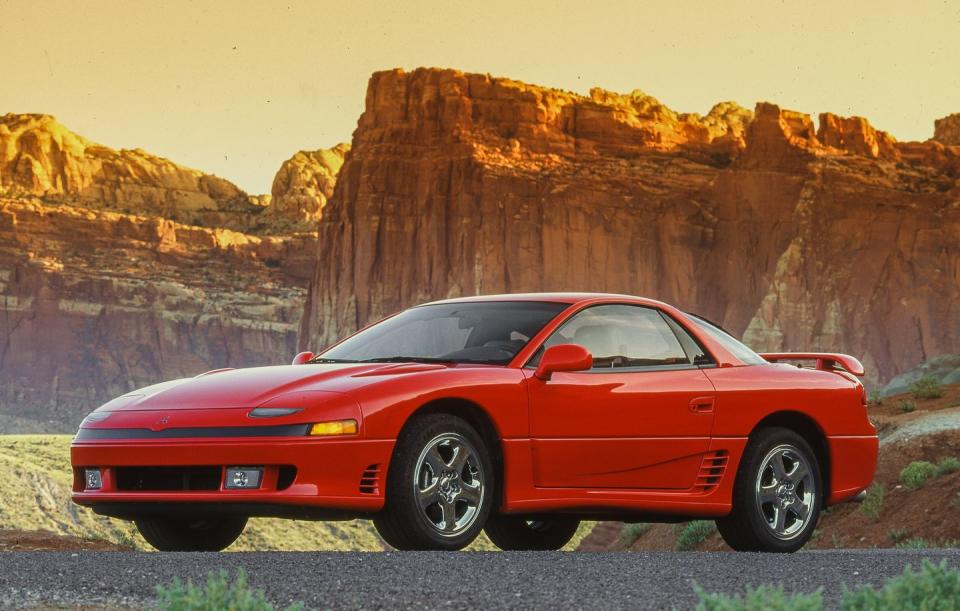
We have repeatedly described Mitsubishi's big-boomer as "the Swiss Army knife of sports cars." The biggest such item you can buy, it includes the equivalent of every blade, corkscrew and toothpick invented since the dawn of the Chromium Age. No matter where you open up this blade runner, it'll wow all onlookers.
Of the two biggest items to brag about, you will find one stuffed under the hood and the other tucked under the car. The first is the engine, a twin-turbo, intercooled 24-valve V-6. It 3.0-liter size might sound teensy considering it has to push-pull almost two tons of Mitsu, but it whirs out 300 hp at 6000 rpm and enough torque—307 lb-ft way down at 2500 rpm—to hurl this big cut-up around as easily as a throwing knife.
The second attraction is a full-time four-wheel-drive system that allows the driver to keep all that power on the job. The front suspension uses struts and coil springs, the rear is a multilink design with coil springs. Both ends sport anti-roll bars and electronically controlled shock absorbers that are two-way adjustable from the driver's seat, or maybe by a passenger who is ill-amused (or just ill) due to the rocket ride (0 to 60 in 5.5 seconds) hat he/she is likely getting.
Michelin XGT-Z tires, 245/45ZR-17s all around, deliver 0.93-g grip on the skidpad and 161-foot stops from 70 mph, stunningly good from a machine of such heft.
Just as amazing, in emergency-lane change testing, the 3000GT VR4, the biggest car of all, finished a rousing second to the smallest, the RX-7. Notes logged on the lane-change behavior by our Mr. Markus: "The four-wheel drive pulls the car through the finish under power quite well. Giant tires and good power also account for the superior performance. It doesn't feel as good at the wheel though."
Notes on the Mitsubishi from the logbook showed the same ambivalence from others: "Sort of feels like the Harley of the bunch-big, fancy, heavy-but not the most desirable mount all things considered. On some of the joint-patched stretches of I-15, the ride is very good even with the shocks set in the Sport mode. On twisty back roads, I'm constantly aware of the mass whose direction must be changed."
"The Mitsu's low, close windshield header makes the car feel claustrophobic. Perhaps the new power mechanism in the seat has raised the cushion." Ironically, the tallest of us, at six-foot-five, sits far enough back not to feel the pinch at the hairline.
"Bulky old thing," says another editor. "But it makes the best sound. Good low-rpm torque makes the 3000 a good tourer. Handling is bland, but it hangs on well, and the 4wd makes weight transfer much less of an an than it is in the RX-7."
"Run less than all-out, the brakes are no longer a worry. Suspension calibrations have been improved, too. Just too big, though the improved dynamics make it feel about 20 percent smaller now. Make that 20 percent less large. Just not my cup of gruel."
"Gimmicky styling and excess of gadgets."
This Mitsubishi proves that, in terms of all-capable cutlery, too fat and fancy a knife can render it inappropriate to a lean, specialized task. Finished off by a next-tolast finish on the racecourse, the 3000GT VR4 finishes last overall.
C/D TEST RESULTS
1993 Mitsubishi 3000GT VR4
• 300-hp twin-turbo V-6, 5-sp manual, 3860 lb, base/as-tested price: $38,492/$39,876
60 mph: 5.6 sec
1/4 mile: 14.1 sec @ 99 mph
Top speed (drag limited): 155 mph
Braking, 70–0 mph: 161 ft
Roadholding, 300-ft-dia skidpad: 0.93 g
C/D observed fuel economy: 13 mpg
5th Place: Porsche 968
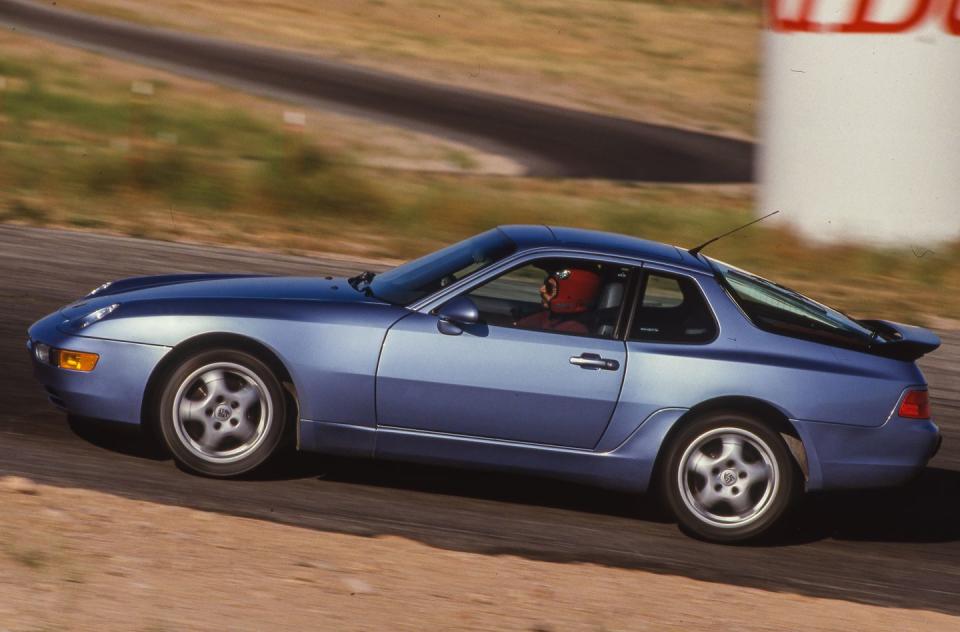
Porsche's front-engined, four-cylinder two-plus-two began life in the Seventies as the 924. We loved its character, execution, and behavior, all typical of German road-burners. But the market changed when sports/GTs became exercises in rocketry and the dollar dipped versus the deutsche mark. Porsche found itself at a severe disadvantage.
Two years ago the hurly-burly 968 showed up. It contained the world's most powerful normally aspirated four-cylinder. Huge for a four at 3.0 liters, it churns out 236 hp, least in our test. Thanks to a lowish curb weight of 3180 pounds (only 340 pounds more than the Mighty Mouse Mazda), the Porsche grunts to 60 mph in 5.9 seconds.
At the other end of the speed-oh!meter, the 968's power curve is sufficiently lofty to produce a 153-mph top speed. True, it's the "slowest" of the field, but the group is tightly packed, with the Porsche only 5 mph down on the 158-mph Corvette, the fastest.
The 968's cabin unfortunately follow the 911 in offering—other than superb gauge—the most helter-skelter ergonomic around: switches, buttons, and levers are strewn all over the interior. Worse, this 968's structure was not impressive. The body creaked and flexed, and the hatch rattled regularly. Going down a dirt road that clung to a mesa, the hood and front fenders set up a St. Vitus dance.

The 968 dances more nicely on good road. The suspension's front strut and rear semi-trailing arm and torsion bars, partnered by anti-roll bar, make it a decent partner for a Utah barn dance. Yokohama A-008P tires complement the seventeen-inch wheels-wider ones on back to offset the slight rear weight bias-and the 968 hooked onto the skidpad at 0.91 g. The Porsche finished near the bottom in lane change, actually spinning once, but stopped from 70 mph in 167 feet.
Porsche log scribblings: "Feel dated, with not much poke at Utah altitudes. But this thing is set up nicely for the driver with great pedal placement. You can match down shift revs almost perfectly. Pity it has a heavy flywheel, leisurely throttle response, and tire that don't like the wet. It keep up in the twisties, though."
"I derive no pleasure from this gigantic four-banger. One must rev the cowpies out of it. The shifter's reverse lockout isn't strong enough to keep 3-2 downshifts from straying into reverse. But I think the 968 may be my styling favorite. Of course I like the Vette' look, too. Am I catching a retro phase?"
"This Porsche's suspension is harsh for no good reason. There seems to be no compliance, so you feel every grain in the road. But on bigger bumps the suspension isn't all that stiff, and the 968 goes down the road rather well. All told, a very coarse car—perhaps the poorest example of a 968 or 944 that I've tried. It feels like a penalty box after the Nissan."
Better: "The Porsche offers involvement the others, except the RX-7, don't."
Warming to it late: "Alright, now the whining can stop—the 968 is completely in its element on the snakiness of Highway 89. One-dimensional compared with the real stars, but more likable as the adrenaline build."
The Porsche, due primarily to it lack of horsepressure, wound up slowest on the racecourse, more than four seconds a lap down on the fastest. That helped seal the 968's fifth-overall fate.
C/D TEST RESULTS
1993 Porsche 968
• 236-hp inline-4, 6-sp manual, 3180 lb, base/as-tested price: $41,743/$47,443
60 mph: 5.9 sec
1/4 mile: 14.6 sec @ 96 mph
Top speed (drag limited): 153 mph
Braking, 70–0 mph: 167 ft
Roadholding, 300-ft-dia skidpad: 0.91 g
C/D observed fuel economy: 14 mpg
4th Place: Chevrolet Corvette
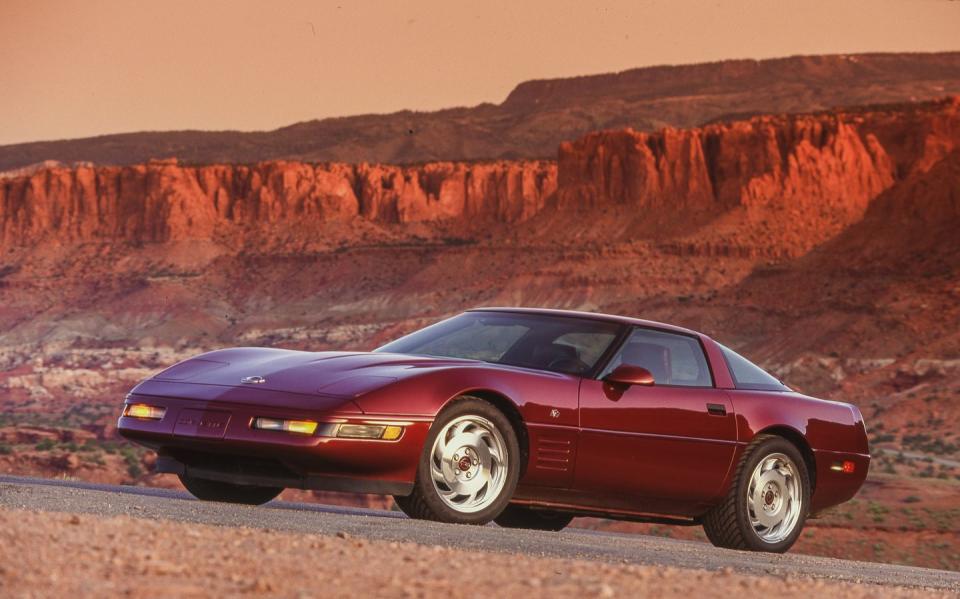
The Chevy has slipped in the hierarchy. Less plasticky, more fantastic, and faster cars have come along to demote it. Somehow, we still count on the Corvette for uncommon performance.
Like the 968, this particular LT1 truck us as unrepresentative, with lackluster motor, grumpy drivetrain, and a bucket-of-bolts feel. Yet the Vette retains the aura of a triple threat. How else do you explain a mid-pack finish for a design that's been on the road for a decade?
Chevy's V-8 has been around four times as long. Despite modem electronic controls and fuel injection, it rumbles as if the Fifties never died. You wonder if this motor ever will, considering its 300 hp.
The Vette is still big and pointy. Still has that frame integral with the fiberglass body, however creaky. Still has those transverse plastic leaf springs. Still has three settings for electronically adjustable shocks to tailor ride and handling. Despite the sizable outer dimensions, the insides seem to have collapsed in on the passenger space. The looming seats and vast dash layout, though striking, are more overwrought than helpful to occupants.
Yet something attracts the faithful. Maybe it's the commotion incurred by putting the Goodyear Eagle GS-C tires to work. The 275/40ZR-17s are the fattest meats on any of these sports/GTs. We wish they could flatten truck ruts in pavement, which send the Vette wobbling.
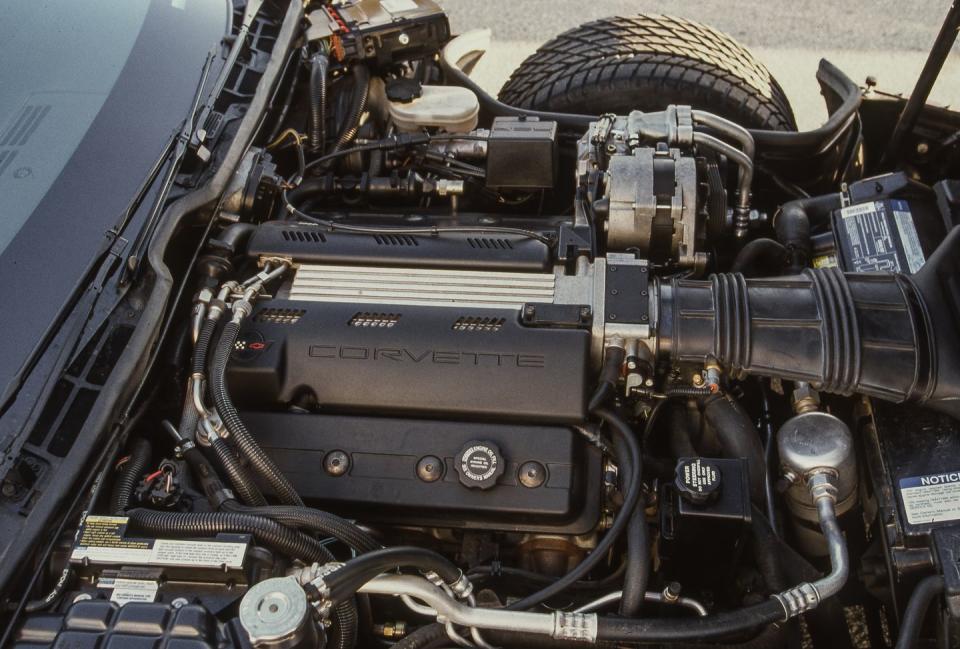
On smooth road, the monkey business turns mountain-gorilla serious. You can hammer from 0 to 130 mph in 26.3 seconds and from 0 to 60 in only 5.4 seconds, second and third quickest. And the LT1's street start to 60 is quickest at 5.8 second. Then there's that 158-mph highest top speed.
But the Corvette can only lap the pad at 0.89 g, tying the Nissan for least grip. And the Vette only stops from 70 mph in 176 feet, longest of all and ten feet longer than the group average.
Fuel economists will be glad to hear that on our genteel 1500-mile tour, this American model attained the highest economy figure. Make what you will of our 15 mpg.
Log quotes: "Tremendous chatter in clutch and grinding noise coming from transmission. On uphill freeway you must downshift to fifth to keep up. I really like the throaty exhaust note on this car. Shocks ride nicely when set in Touring mode."
Flip side: "God, this is awful on lumpy, quick road. None of the suspension settings offers a good compromise. Driving becomes a wrist-wrestling match with the wheel rather than a copacetic flow."
“This Vette comes up short in refinement. The shifter is heavy, and everything feels chunky. The engine seems gutless at 8000 feet. Contrary to my colleagues, I think the car stick to the road pretty well and feels secure."
"Wind roar, tire roar, spurious steering feedback, limited pace, high sills, and a drivetrain as raucous as a race car. You gotta love it!"
In the end, our lack of all-around esteem dropped the Corvette to fourth of six.
C/D TEST RESULTS
1993 Chevrolet Corvette
• 300-hp V-8, 6-sp manual, 3420 lb, base/as-tested price: $35,660/$41,026
60 mph: 5.4 sec
1/4 mile: 14.0 sec @ 103 mph
Top speed (drag limited): 158 mph
Braking, 70–0 mph: 176 ft
Roadholding, 300-ft-dia skidpad: 0.89 g
C/D observed fuel economy: 15 mpg
3rd Place: Mazda RX-7
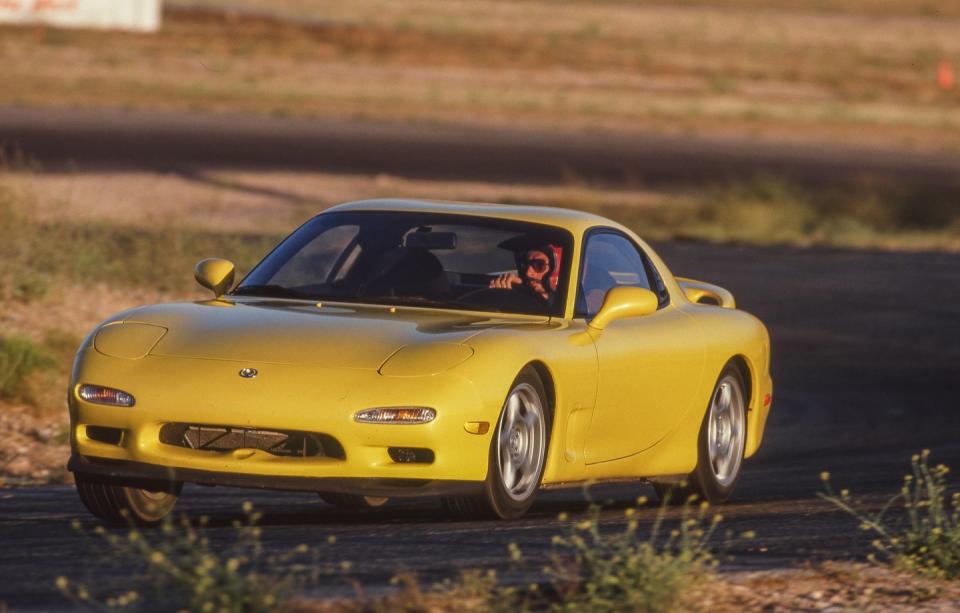
Most of us are smitten by Mazda' premise for the RX-7: "Build it Little and light and big fat butts will be kicked."
A year ago we grabbed from Mazda one of its twin-turbo rotary pocket rockets for a long-term test. Our 35,000-mile history with it brought a string of dealer visits and frustrations. We approached the chance to try another RX-7 hoping it would confirm the worth of Mazda's flyweight philosophy. To Mazda's chagrin, the gearbox synchros in this one got graunchy; in the tradition of born buttkickers, though, that didn't keep it from taking second at the track.
The RX-7 is the only pure sports car in the group. Under the roundness of its light fenderware and hood are some of the most artful components ever created for a mass-production car. Like the Lotuses once created by Colin Chapman, the RX-7 makes you wonder at a creation so trim yet capable of creating performance so strong that it seems impossible.
The two-rotor Wankel engine's intake charge is boosted by two sequential turbos. It nominally measures 1.3 liters yet produce 255 horsepower at 6500 rpm-so stout in a car of 2840 pounds that the low torque of 217 lb-ft at 5000 rpm is no problem. The Mazda's high power, low mass, and low drag made for a 0-to-60 time of 5.3 seconds and a top speed of 157 mph (runner-up in both by just one notch).
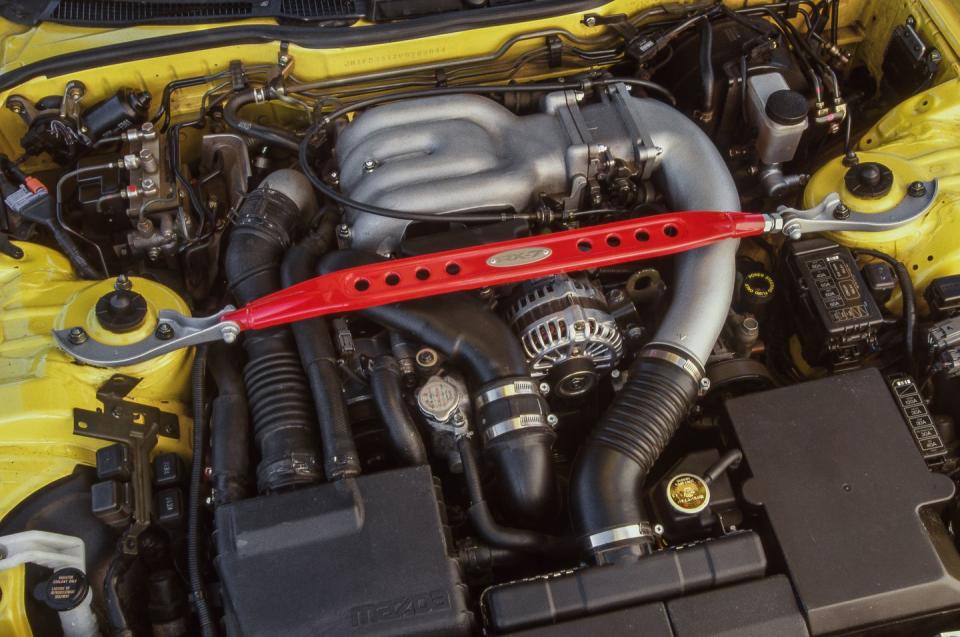
Most adults speak of the RX-7's glove-like cockpit. There are snug seats for making best use of the unequal-length control-arm suspension and 225/50ZR-16 Bridgestone Expedia S-07s. The RX-7 was top leech in traction events. It won braking with an arresting-hook 156-foot stop, roadholding with a near-unbelievable 0.99 g, and the lane-change by more than 2 mph, Markus intoning: "Clearly nimblest of all."
"Great driving position," reads the log. "Very comfortable eating. I've always liked the shrink-wrapped feeling in this car, but the interior finish could be richer."
"It's hard to drive smoothly in town, forever bounding between power delivery and overrun, but it's okay on the road. There's a peculiar whistle from the exhaust when the boost is up, but it's accompanied by serious thrust, so you get to like it."
"Almost all the RX-7's shortcomings dissolve when you hit the twisties, where you want a car this small, stiff, and agile. With the turbos buzzing in harmony with the tires, you zip around as if on wings. Plus these tires stick like flypaper," signed "The Fly."
"On winding roads, the RX-7 is hard to fault. Plenty of power, grip, and feel, excellent steering, great stability. Going fast is a snap. I especially like its willing feel, hurling into comers eagerly."
"It's sensational on the twisties out of Prescott—never any duress or doubt. The bite, balance, and brakes are A-1. Just about perfect for going the snakiest way with little chance of getting bit."
Perhaps only our concerns about its reliability held the RX-7 to third.
C/D TEST RESULTS
1993 Mazda RX-7
• 255-hp sequential-turbo 2-rotor Wankel, 5-sp manual, 2840 lb, base/as-tested price: $33,603/$35,252
60 mph: 5.3 sec
1/4 mile: 14.0 sec @ 100 mph
Top speed (drag limited): 157 mph
Braking, 70–0 mph: 156 ft
2nd Place: Nissan 300ZX Turbo
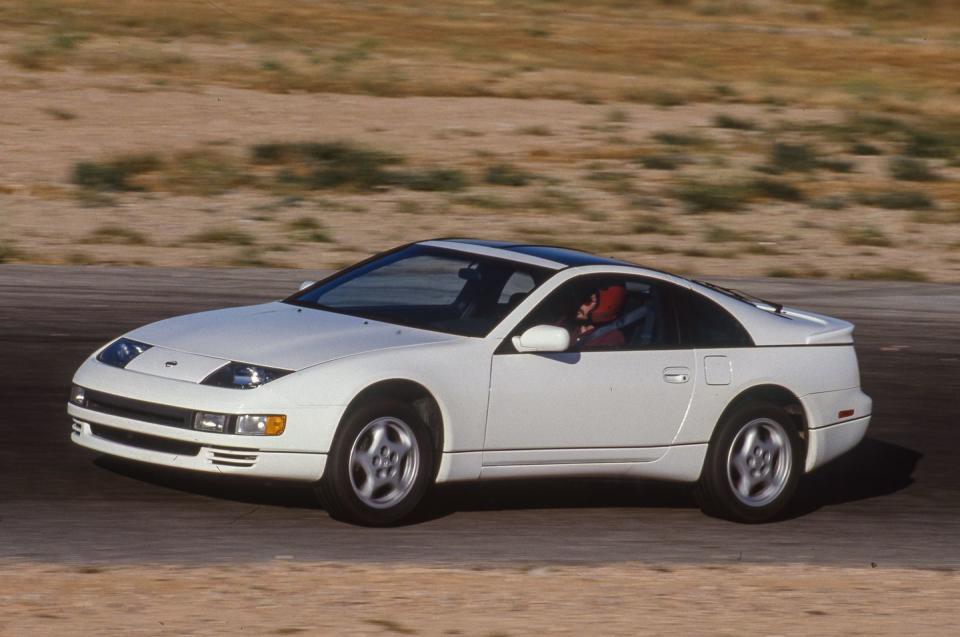
The essence of solid character forever percolates under the taut, curved skin of Nissan's twin-turbo. Its proportions still look good enough to work like caffeine for the eyes. Looking deeper, those two turbos and the chassis dynamics are what really make the peepers fly open. It happens every time we think of the car, sitting quietly, lying low, waiting for someone to claim it with a twist of the key.
Several times the 300ZX Turbo has turned the key to C/D's heart and claimed-make that, stormed-a top spot in a comparison test. Experience has shown that our votes were well cast. A moonshot performance car from the start, the ZX remains a sweetheart to set up house with. It can do things for you that less clever partners cannot.
Still has that broad engine overflowing the power bay, too, with power to spare, 300 horsepressure of it at 6400 rpm. And the 300ZX till cuts a fine, fast swath. It finishes the 0-to-60 runoff in 5.6 seconds, suddenly four-tenths of a second too slow to equal the fastest of all. But it hauls all the way to 155 mph, and could go higher without the electronic cutoff.
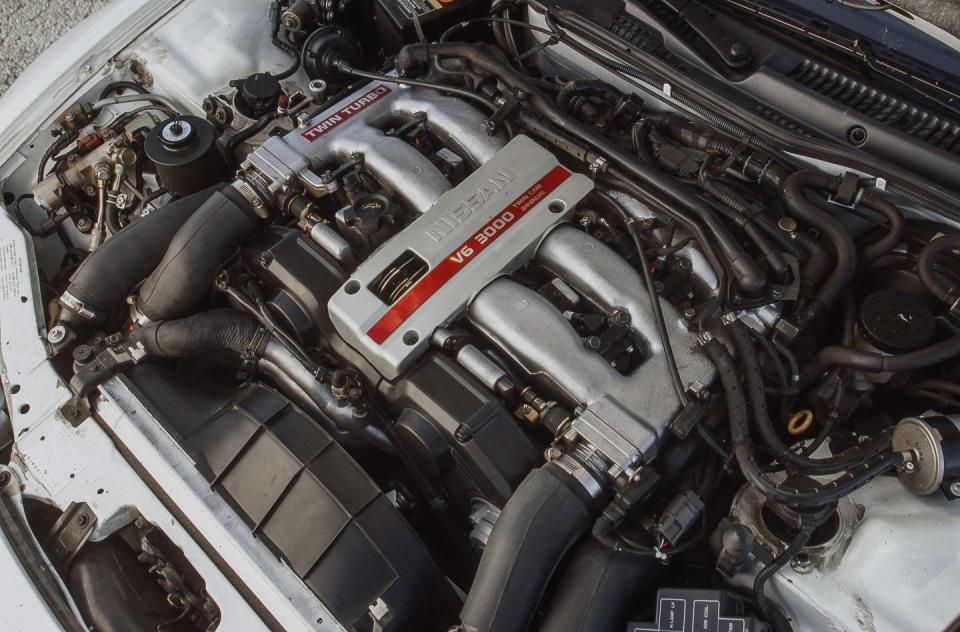
In this pack, the 300's big shortfall is in grip. Emergency tops from 70 require 175 feet, within a foot of last place. In roadholding, Nissan ties Chevy for last at 0.89 g. Like the Porsche and the Toyota, the 300's tires come in different sizes for front and rear, which is not heartening for long drives to nowhere place where there won't be any replacement tires. Despite the similar figures generated by the Chevy and the Nissan in traction tests, the Vette comes across as unsettled on its suspension, while the Nissan has become closer to unflappable.
The Nissan's log revealed mostly agreement: "The Queen Mum of these cars, aging gracefully. Only the spongy brake pedal bothers me. Oh, and the add-on pod for the climate control and light switches."
"Stepping into the Nissan out of the Mitsu, I feel as if I just swapped a hiking boot for a running shoe; the 320-pound difference is quite pronounced. The ZX is just much more willing to do your bidding."
"This one works superbly in almost all modes. It feels better coordinated than I remember. The brakes in particular feel more effective."
"I went lickety-split into a sweeping bend only to find it wet. There was a moment's apprehension and the car went maybe four inches off line, but neither end stepped out. And the 300ZX ha more character than the Supra."
"Quite wieldy in the tight stuff. Having to use second gear instead of a too-high third means a lot of torque goes down in tight, full-throttle exit. Which brings the rear slithering out. There's plenty of time to let off a bit and gather it up, but the Nissan just doesn't have that running-in-a-lot feel that the Supra has."
Somewhere along the way, a nucleus of such feeling took hold with enough of us to barely displace Nissan's wonderful 300ZX Turbo from the top slot to second.
C/D TEST RESULTS
1993 Nissan 300ZX Turbo
• 300-hp twin-turbo V-6, 5-sp manual, 3540 lb, base/as-tested price: $38,806/$38,806
60 mph: 5.6 sec
1/4 mile: 14.2 sec @ 101 mph
Top speed (governor limited): 155 mph
Braking, 70–0 mph: 175 ft
Roadholding, 300-ft-dia skidpad: 0.89 g
C/D observed fuel economy: 14 mpg
1st Place:
Toyota Supra Turbo
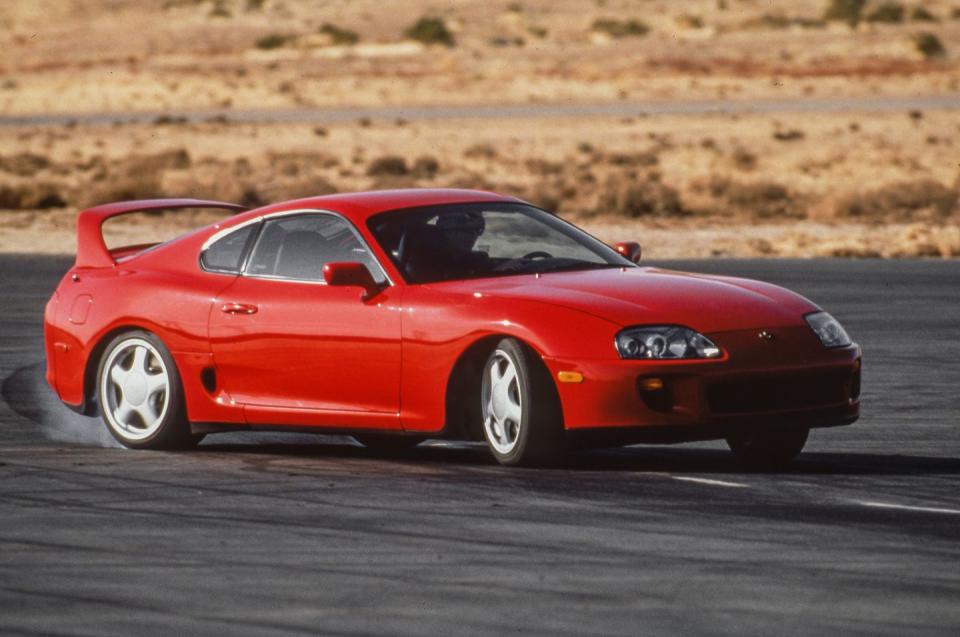
Often in sports and sometimes in the art and humanities we speak of a "natural." One perfectly suited to a special, gifted path in life. A Mickey Mantle. An Andrew Wyeth. A Helen Keller. A Martin Luther King Jr. Those who, when they come to play, to create, to perform great works, whether out of fun or necessity or conscience, are somehow absorbed by that great thing and become as much a part of it as it is of them. The new Toyota Supra Turbo is surely a natural.
This special car almost does it all. If it could carry the Mormon Tabernacle Choir in the dimple-size back seats, take stud horses to see their dates, and cross the Great Salt Lake without water wings or corrosive damage, all of Utah would have been at our feet.
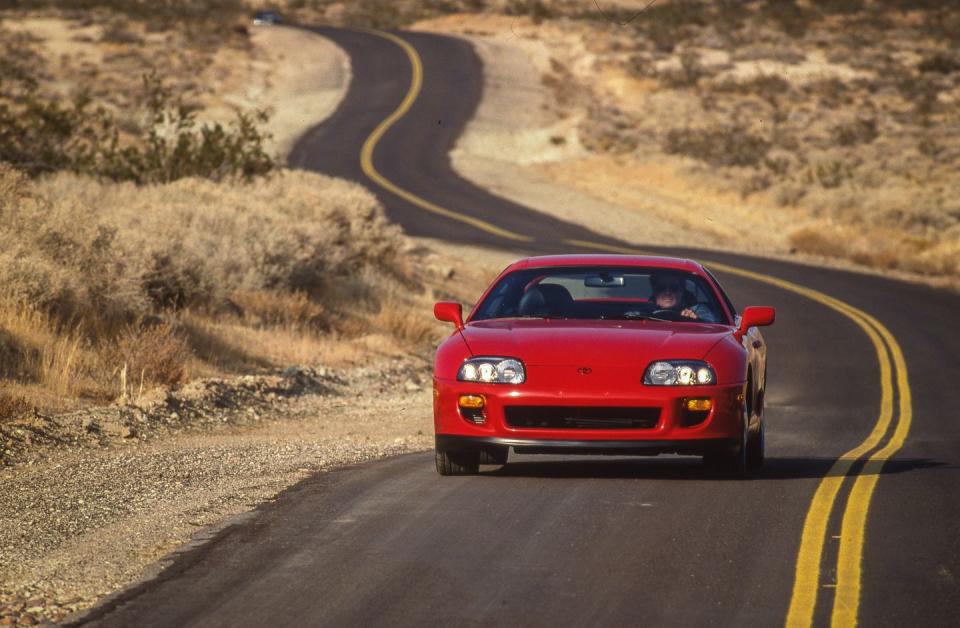
Sayeth the Supra logbook:
"There's a demonic wind howl at the air-vent intake at the bottom of the windshield. And there's no cupholder. But the handling behavior is nicely sensitive to throttle changes even at a merely brisk pace. Confidence level exceptional."
"It feels big but, man, is it planted. The steering is nicely alive and the car turns in beautifully. The brakes are magnificent—I've never tried better. The engine is real strong but there's more turbo whistle than exhaust snarl. Still, the thing pulls like a train, and it is extraordinarily composed. Shift throws are short and the action is light if somewhat mechanical. The interior is clever, though fairly stark, and looks and feels roomy."

What, then, hath Toyota wrought?
An everyday practical, usable car—a coupe with room for two adults and devil take the hindmost. (So it's a two-plus-two that's quite comfortable for the front two unless either is much over six feet.) Room for a surprisingly large amount of soft luggage. Surprisingly little room for much hard luggage. A body structure that remained distinctly solid both during and after the duress of hard driving, even on very bad roads. A rocket car whose drivability remained virtually flawless after 1500 miles of every imaginable type of driving. There was an occasional flat spot in the boost, but it might have been caused by one loose connection among the many in the twin-turbo system's plumbing.
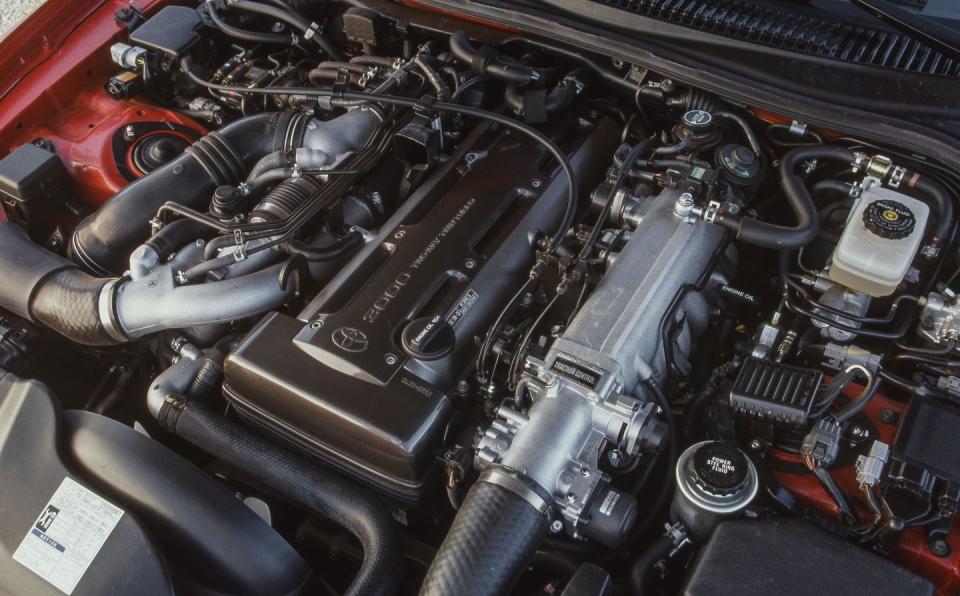
All the numbers are impressive: 0 to 60 mph in 5.2 seconds and 0 to 130 mph in 22.5 seconds. The quarter-mile in 13.8 seconds at 106 mph. Top speed of 154 mph (governor limited). Braking from 70 mph in 160 feet. And roadholding of 0.95 g. Plus, a huge margin of victory in lap times at Willow Springs. The prototype we tested in March demonstrated even more straight-line speed, but we put our faith in these production-car numbers.
The regular Supra 's base engine is shared with the Lexus SC300 and GS300, producing 220 hp for each. The twin-turbo setup, on the other hand, operates sequentially so that the smaller turbo hits full boost somewhere around 2500 rpm, and at 4500 rpm the big mutha clobbers your body like a bungee jump gone wrong.
Fair warning: Take care with the throttle if you've switched off the traction control. Imprudent pressure from your right foot in a hard corner will kick the tail out in a hurry. This hulking device is not to be taken lightly, even if you've spent a quarter-century of adulthood testing fast cars and belting around racetracks and outback.
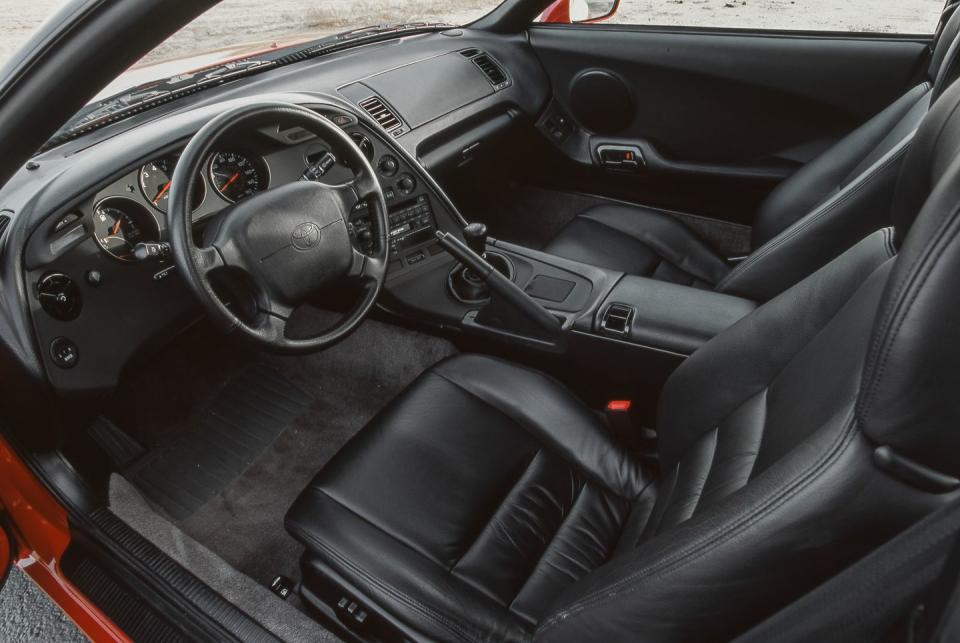
The Supra's excellent instruments, set among a somewhat industrial-looking but efficiently organized dash layout, are highlighted by a huge tach centered behind the handy four-spoke steering wheel. If the Mazda's interior fits like a custom-made glove, the Toyota fits more like a very good mitten.
Seeing through that wing towering in the rear-view mirror is actually a snap. There's much better visibility out the back than in the 300ZX, which has only a low lip at the base of the rear window but an extremely low roofline back there, creating a major blind spot that hides anything lurking beyond middle distance.
We went way beyond the middle distance on this one. When the 1500 miles of hard driving, heavy sweating, big grinning, and tough voting were done, only the Toyota won any categories outright. One of the three it claimed was the overall win. Out of the 100 points possible for the big prize, the Toyota scored 96, beating the Nissan by one point.
C/D TEST RESULTS
1993 Toyota Supra Turbo
• 320-hp twin-turbo inline-6, 6-sp manual, 3480 lb, base/as-tested price: $40,890/$43,734
60 mph: 5.2 sec
1/4 mile: 13.8 sec @ 106 mph
Top speed (governor limited): 154 mph
Braking, 70–0 mph: 160 ft
Roadholding, 300-ft-dia skidpad: 0.95 g
C/D observed fuel economy: 14 mpg
You Might Also Like

 Yahoo Autos
Yahoo Autos 